Menus
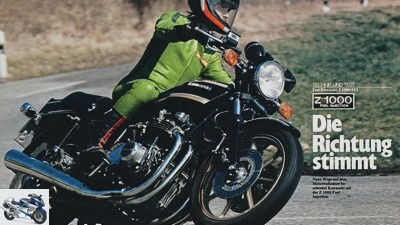

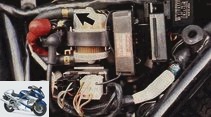
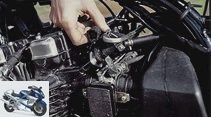
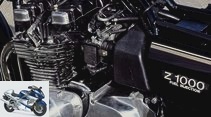
17th photos

1/17
The control unit tells the system what to do when and with what quantity.

2/17
Instruments like on the Mk II; emphasized factual, blink control too deep.
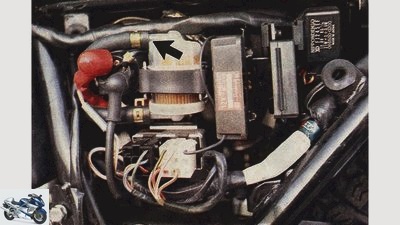
3/17
The upper petrol line (arrow) must be pulled off for bleeding.

4/17
Plug connections for the electromagnetic injection valves; the so-called "almost idle"-Lever does the same thing as a choke, but only opens the throttle.

5/17
Only the throttle valves remain of the carburetor battery.
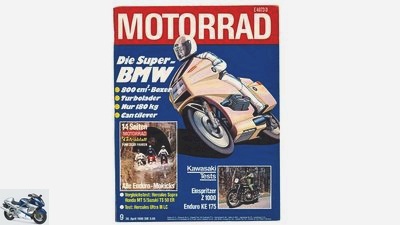
6/17
The first test of the Kawasaki Z 1000 Fuel Injection with electronic fuel injection could be read in MOTORRAD 9/11980.
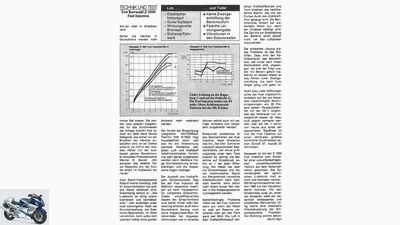
7/17
Kawasaki Z 1000 EFI, page 3.
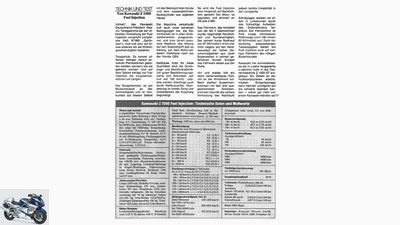
8/17
Kawasaki Z 1000 EFI, page 2.
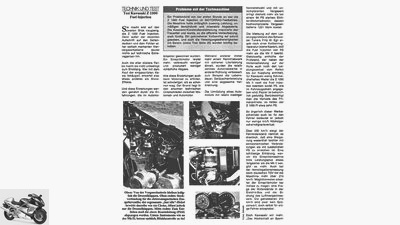
9/17
Kawasaki Z 1000 EFI, page 1.
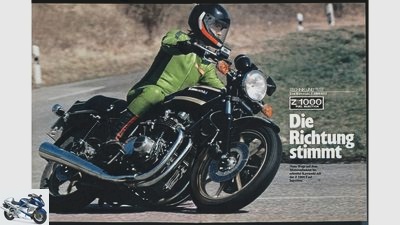
10/17
In 1980, Kawasaki offered a bike with the Z 1000 Fuel Injection, which earned the fame much later due to its pioneering role.
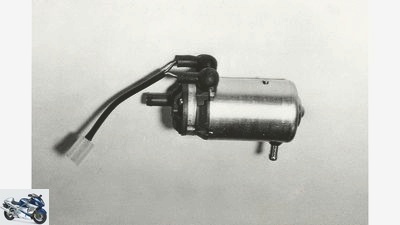
11/17
The fuel pump provides injection pressure.
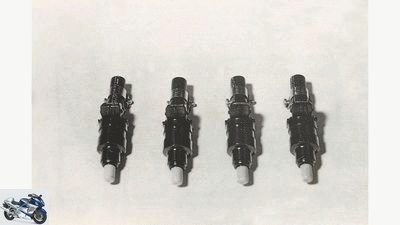
12/17
Injectors, electronically controlled.
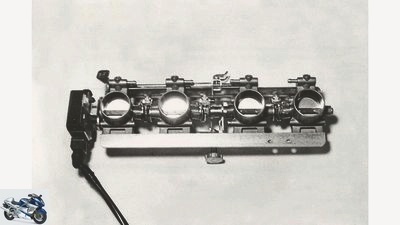
13/17
Throttle valves regulate the amount of air.
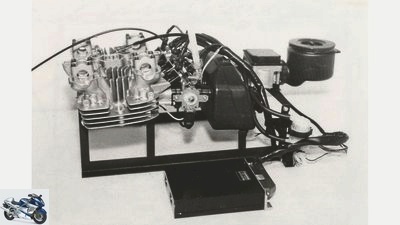
14/17
The most important components of the Kawasaki injection system: air filter (far right), air flow meter (2nd from right), electronic control unit (far below), throttle valve (middle), injection valves (middle above).

15/17
A complex system of sensors measures various current values and supplies the control unit.
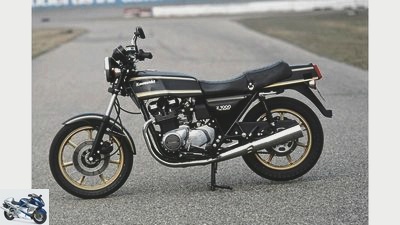
16/17
At first glance a Mk II, at second glance, a specialist recognizes the fuel, which is only built in small numbers.
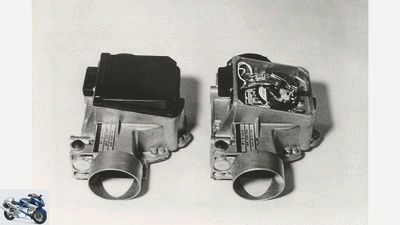
17/17
The air flow meter measures the exact amount of air to optimize the mixture.
Test of the Kawasaki Z 1000 EFI
Reprint from MOTORRAD 9/1980
Content of
The Kawasaki Z 1000 EFI broke new ground with its petrol injection. In an article in issue 9/1980, MOTORRAD illuminated the new technology. And we add an assessment from today’s perspective.
The 5-page test of the Kawasaki Z 1000 Fuel Injection from MOTORRAD 9/1980, you can see and read in the picture gallery. Simply click on the first page and enlarge it.
Buy complete article

Test of the Kawasaki Z 1000 EFI
Reprint from MOTORRAD 9/1980
The Kawasaki Z 1000 Fuel Injection from today’s perspective
Explorers, visionaries and inventors often share the same fate: At first they are ridiculed, not taken seriously, they are not given the respect or even the fame they deserve. The Kawasaki Z 1000 Fuel Injection also somehow belongs to this species of geniuses that were initially misunderstood. Although it caused quite a stir among technology enthusiasts and the consistent implementation of injection technology in a motorcycle earned cautious applause, in 1980 there was still not a broader understanding of the benefits and necessity of injection. Especially since with a nominal 97 hp it was exactly on the level of its card-driven sister Z 1000 ST and also had no really serious advantages to offer compared to the carburetor versions ST and (the chain-driven) MK II in terms of performance.
Just a gimmick for technology connoisseurs? Not at all. Only gradually did we all realize how important the first step was, which was to lead to the injected GPZ 1100 B1 in the following year and from 1982 with the B2 to the further developed models with DFI (Digital Fuel Injection). Reducing consumption, but above all, as we know today, reducing pollutant levels in exhaust gas should be the issues of the future, and that is where FI dared to take the first decisive step. The homologation of a new vehicle with carburettors? Practically unthinkable today. Almost every new 125 today throws the carburetor overboard in favor of injection.
And I admit, I also devoured the test of the Z 1000 FI as a teenager, was enthusiastic about the design and dreamed of being able to drive such a bullet one day. But I was also a little puzzled that the Fuel Injection did not do much better and did not work that much better than a carburetor MK II. Today I not only take my hat off to the pioneering work of the developers, but also consider the one that is now due to push a not inconsiderable sum over the counter in case one of the rare copies of the Fuel Injection should be offered for sale. Alone to show her the respect it deserves, a good 35 years late.
The technique of injection
What is right for the automotive sector should be cheap for the motorcycle sector. This is what Kawasaki thought at the end of the 1970s and finally presented the first production motorcycle with fuel injection for the 1980 model year. The technical basis for this is provided by a license from Japan Electronic Control System Co. Ltd. (JECS) manufactured Bosch L-Jetronic. The advantages and goals were a much smoother, rounder engine running from low engine speeds and more spontaneous reaction to gas commands, better exhaust gas values, more uniform, overall higher power output and lower consumption.
This is made possible by the basic advantages of injection compared to the carburettor, i.e. the separation of air and fuel flow and the more varied options for taking into account the operating state of the engine. Five pieces of information, some of which are recorded by sensors, are processed by the control unit, which Kawa also mockingly calls “the lunch box”: cylinder head temperature, air volume, throttle valve position, engine speed and intake air temperature. The amount of fuel and the duration of the injection are calculated from this data. A fuel pump supplies the fuel pressure required for this. Due to the large amount of space required by the many components – the voluminous air flow meter already takes up a lot of space – the control unit had to make way: for the European version under the rear bumper, for the American version under the seat.
Related articles
-
Aprilia Tuono V4 1100 RR, Kawasaki Ninja H2 and BMW S 1000 XR in the comparison test
Arturo Rivas Gonzalez 31 pictures Arturo Rivas Gonzalez 1/31 Aprilia Tuono V4 1100 RR, Kawasaki Ninja H2 and BMW S 1000 XR. Arturo Rivas Gonzalez 2/31 And …
-
BMW R 90 S, Kawasaki 900 Z1, Laverda 1000 3C Big Bikes
fact 30 pictures fact 1/30 Big-Bike classic from the 70s – pure fascination. Kawasaki 900 Z1, Laverda 1000 3C and BMW R 90 S from MOTORRAD Classic …
-
BMW F 800 GT, Kawasaki Z 1000 SX and Honda VFR 800 F in the test
fact 44 pictures fact 1/44 fact 2/44 fact 3/44 fact 4/44 fact 5/44 Praise to the diversity: The three test candidates all want the same thing, but are looking for it …
-
Kawasaki ZL 1000 and Yamaha Vmax
Stefan Wolf 38 Image archive 1/38 The “new” Vmax, in the range since 2008, also boasts superlatives in terms of performance, acceleration and …
-
fact Concept comparison Honda CBR 1100 XX Kawasaki ZX-12 R Suzuki GSX-R 1000 Suzuki GSX 1400 Yamaha FZS 1000 Fazer Yamaha FJR 1300 Six bombs The six …
-
BMW S 1000 XR, Kawasaki ZZR 1400 and KTM 1290 Super Duke GT in the test
Andreas Riedmann 25 pictures andreasriedmann.at 1/25 picture gallery comparison test, power-speed touring bikes: BMW S 1000 XR, Kawasaki ZZR 1400, KTM 1290 …
-
Kawasaki ZX-10R and BMW S 1000 RR in a comparison test
www.bilski-fotografie.de 25 pictures www.bilski-fotografie.de 1/25 Let’s first take a look at the new Kawasaki ZX-10R. www.bilski-fotografie.de …
-
Kawasaki Versys 1000 driving report
Wright driving report: Kawasaki Versys 1000 (with video) Kawasaki’s all-rounder now with a large four-cylinder No half measures: For the Versys there is now the …
-
Kawasaki Versys 1000 – The four-cylinder tourer
Gargolov Test: Kawasaki Versys 1000 The four-cylinder touring bike from Kawasaki Covering long distances with a pillion passenger and a lot of luggage, briskly over …
-
Endurance test final balance of the Kawasaki Z 1000
Gargolov Endurance test final balance Kawasaki Z 1000 The naked bike after 50,000 km With the Kawasaki Z 1000, the 40-year tradition of the Z series …